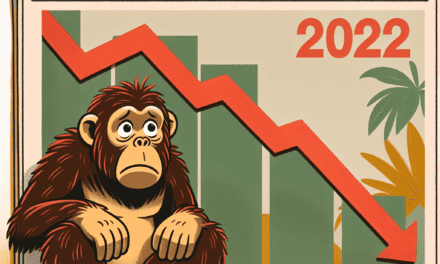“BlackRock’s Tokenized Treasury Fund: Pioneering Growth to $375 Million in Digital Finance.”
Introduction
BlackRock’s Tokenized Treasury Fund has experienced significant growth, reaching a valuation of $375 million. This development marks a notable milestone in the financial sector, highlighting the increasing adoption and integration of blockchain technology within traditional finance. The fund, which tokenizes U.S. Treasury securities, offers investors enhanced liquidity, transparency, and efficiency, aligning with the broader trend of digital transformation in asset management. BlackRock’s initiative reflects the company’s strategic focus on innovation and its commitment to providing cutting-edge investment solutions to meet the evolving needs of its clients.
Growth Trajectory: Analyzing BlackRock’s Tokenized Treasury Fund Expansion
BlackRock’s Tokenized Treasury Fund has recently reached a significant milestone, growing to an impressive $375 million. This development marks a pivotal moment in the financial sector, as it underscores the increasing acceptance and integration of blockchain technology within traditional financial frameworks. The fund’s expansion is not only a testament to BlackRock’s strategic foresight but also indicative of a broader trend towards the digitization of financial assets.
The growth trajectory of BlackRock’s Tokenized Treasury Fund can be attributed to several key factors. Firstly, the increasing demand for digital assets has played a crucial role. As investors seek more efficient and transparent ways to manage their portfolios, tokenized assets offer a compelling solution. By leveraging blockchain technology, these assets provide enhanced liquidity, reduced transaction costs, and improved accessibility. Consequently, institutional investors are increasingly drawn to tokenized funds as a means to diversify their holdings and optimize returns.
Moreover, BlackRock’s reputation as a global leader in asset management has undoubtedly contributed to the fund’s success. With a robust infrastructure and a wealth of experience in managing diverse portfolios, BlackRock is well-positioned to navigate the complexities of tokenized assets. The company’s commitment to innovation and its proactive approach to embracing new technologies have further solidified its standing in the financial industry. As a result, investors have shown considerable confidence in BlackRock’s ability to manage and grow the Tokenized Treasury Fund effectively.
In addition to these factors, regulatory developments have also played a significant role in the fund’s expansion. As governments and regulatory bodies around the world begin to recognize the potential of blockchain technology, they are increasingly implementing frameworks to support its adoption. This regulatory clarity has provided a more secure environment for investors, encouraging greater participation in tokenized funds. BlackRock’s ability to navigate these regulatory landscapes has been instrumental in its ability to attract and retain investors.
Furthermore, the macroeconomic environment has also contributed to the fund’s growth. In an era of low interest rates and economic uncertainty, investors are seeking alternative investment opportunities that offer higher yields and greater stability. Tokenized treasury funds, with their potential for enhanced returns and reduced risk, have emerged as an attractive option. BlackRock’s strategic positioning in this market has allowed it to capitalize on these trends, further driving the expansion of its Tokenized Treasury Fund.
Looking ahead, the future of BlackRock’s Tokenized Treasury Fund appears promising. As blockchain technology continues to evolve and gain mainstream acceptance, the demand for tokenized assets is expected to grow exponentially. BlackRock’s commitment to innovation and its ability to adapt to changing market dynamics will be crucial in maintaining its competitive edge. Additionally, as more investors recognize the benefits of tokenized funds, BlackRock is likely to see continued inflows, further bolstering the fund’s growth trajectory.
In conclusion, the expansion of BlackRock’s Tokenized Treasury Fund to $375 million is a significant achievement that highlights the growing importance of blockchain technology in the financial sector. Through a combination of strategic foresight, regulatory acumen, and a keen understanding of market dynamics, BlackRock has positioned itself as a leader in the tokenized asset space. As the financial landscape continues to evolve, the company’s ability to innovate and adapt will be key to sustaining its growth and maintaining its leadership position in this burgeoning market.
Investment Strategies: How BlackRock’s Fund Reached $375 Million
BlackRock’s Tokenized Treasury Fund has recently reached a significant milestone, growing to an impressive $375 million. This achievement underscores the increasing interest and confidence in tokenized assets within the investment community. As the world’s largest asset manager, BlackRock’s foray into tokenization represents a pivotal moment in the evolution of investment strategies, blending traditional financial instruments with cutting-edge blockchain technology. The fund’s growth can be attributed to several key factors, each contributing to its burgeoning success.
Firstly, the appeal of tokenized assets lies in their ability to offer enhanced liquidity and accessibility. By converting traditional assets into digital tokens, BlackRock has enabled a broader range of investors to participate in the Treasury market. This democratization of access is particularly attractive to smaller investors who were previously unable to engage with such high-value assets. Moreover, tokenization facilitates fractional ownership, allowing investors to purchase smaller portions of an asset, thereby lowering the barrier to entry and diversifying investment portfolios.
In addition to increased accessibility, the efficiency of blockchain technology plays a crucial role in the fund’s growth. Blockchain’s decentralized nature ensures transparency and security, reducing the risk of fraud and enhancing investor confidence. Transactions are recorded on an immutable ledger, providing a clear and verifiable history of asset ownership. This level of transparency is particularly appealing to institutional investors who require stringent due diligence and risk management protocols. Furthermore, the automation of processes through smart contracts reduces administrative costs and expedites transaction times, making tokenized assets an attractive option for those seeking efficient investment solutions.
Another contributing factor to the fund’s success is the current economic climate, which has heightened interest in stable and secure investment vehicles. With global markets experiencing volatility and uncertainty, investors are increasingly turning to U.S. Treasury securities as a safe haven. BlackRock’s Tokenized Treasury Fund offers exposure to these low-risk assets while simultaneously providing the benefits of blockchain technology. This combination of stability and innovation is a compelling proposition for investors seeking to balance risk and reward in their portfolios.
Moreover, BlackRock’s reputation as a trusted and experienced asset manager cannot be overlooked. The firm’s extensive expertise and robust risk management frameworks provide an added layer of assurance to investors. By leveraging its established infrastructure and industry knowledge, BlackRock has successfully navigated the complexities of integrating blockchain technology into traditional financial systems. This seamless integration has been instrumental in building investor confidence and driving the fund’s growth.
Looking ahead, the continued expansion of BlackRock’s Tokenized Treasury Fund is likely to inspire further innovation within the asset management industry. As more investors recognize the potential of tokenized assets, other financial institutions may follow suit, exploring new ways to incorporate blockchain technology into their offerings. This trend could lead to a broader transformation of investment strategies, with tokenization becoming an integral component of the financial landscape.
In conclusion, BlackRock’s Tokenized Treasury Fund reaching $375 million is a testament to the growing acceptance and adoption of tokenized assets. By offering enhanced liquidity, transparency, and efficiency, the fund has attracted a diverse range of investors seeking innovative solutions in an uncertain economic environment. As the industry continues to evolve, BlackRock’s pioneering efforts in tokenization are likely to pave the way for future advancements, reshaping the investment landscape for years to come.
Market Impact: The Influence of BlackRock’s Tokenized Treasury Fund
BlackRock’s tokenized treasury fund has recently reached a significant milestone, growing to an impressive $375 million. This development marks a pivotal moment in the financial markets, as it underscores the increasing influence of tokenization in traditional finance. Tokenization, the process of converting rights to an asset into a digital token on a blockchain, is revolutionizing how assets are managed and traded. BlackRock, a global leader in investment management, has embraced this innovation, signaling a broader acceptance of blockchain technology within the financial industry.
The growth of BlackRock’s tokenized treasury fund can be attributed to several factors. Firstly, the fund offers enhanced liquidity compared to traditional treasury securities. By tokenizing these assets, BlackRock enables fractional ownership, allowing investors to buy and sell smaller portions of the fund with greater ease. This increased liquidity is particularly appealing to institutional investors seeking to optimize their portfolios without being constrained by the limitations of conventional treasury markets.
Moreover, the tokenized treasury fund provides a level of transparency that is often lacking in traditional financial instruments. Blockchain technology ensures that all transactions are recorded on a decentralized ledger, offering investors real-time visibility into the fund’s performance and holdings. This transparency not only builds trust among investors but also enhances the fund’s appeal to those who prioritize accountability and security in their investment choices.
In addition to liquidity and transparency, the tokenized treasury fund offers cost efficiencies that are difficult to achieve with traditional financial products. By leveraging blockchain technology, BlackRock can reduce the administrative and operational costs associated with managing the fund. These savings can be passed on to investors in the form of lower fees, making the fund an attractive option for cost-conscious investors.
The success of BlackRock’s tokenized treasury fund also highlights the growing demand for digital assets among institutional investors. As the financial landscape continues to evolve, more investors are recognizing the potential of blockchain technology to transform asset management. BlackRock’s foray into tokenization serves as a testament to the increasing acceptance of digital assets as a legitimate and valuable component of diversified investment portfolios.
Furthermore, the expansion of BlackRock’s tokenized treasury fund is likely to have a ripple effect across the financial industry. As one of the largest asset managers in the world, BlackRock’s actions often set trends that others follow. The success of its tokenized fund may encourage other financial institutions to explore similar initiatives, further integrating blockchain technology into mainstream finance. This could lead to a broader adoption of tokenization, ultimately reshaping the way assets are managed and traded globally.
In conclusion, the growth of BlackRock’s tokenized treasury fund to $375 million is a significant development in the financial markets. It underscores the transformative potential of blockchain technology and highlights the benefits of tokenization, including enhanced liquidity, transparency, and cost efficiencies. As institutional investors increasingly embrace digital assets, BlackRock’s pioneering efforts in this space are likely to influence the broader financial industry, paving the way for further innovation and adoption of blockchain technology in asset management. The continued success of such initiatives will undoubtedly play a crucial role in shaping the future of finance, as traditional and digital assets converge in an increasingly interconnected global market.
Technology Integration: Blockchain’s Role in BlackRock’s Fund Success

BlackRock’s Tokenized Treasury Fund has recently reached a significant milestone, growing to an impressive $375 million. This achievement underscores the increasing integration of blockchain technology within the financial sector, highlighting its potential to revolutionize traditional investment mechanisms. As the world’s largest asset manager, BlackRock’s foray into tokenization is not only a testament to the evolving landscape of finance but also a reflection of the growing trust in blockchain’s capabilities to enhance transparency, efficiency, and accessibility in financial markets.
The concept of tokenization involves converting rights to an asset into a digital token on a blockchain. In the case of BlackRock’s Treasury Fund, this process allows for the creation of digital representations of U.S. Treasury securities, which are then made available to investors in a more streamlined and accessible manner. By leveraging blockchain technology, BlackRock is able to offer a more efficient and secure way to manage and trade these assets, reducing the friction and costs typically associated with traditional financial transactions.
One of the key advantages of using blockchain technology in this context is the enhanced transparency it provides. Blockchain’s decentralized nature ensures that all transactions are recorded on a public ledger, which is immutable and accessible to all participants. This level of transparency not only builds trust among investors but also reduces the risk of fraud and manipulation, which are often concerns in traditional financial markets. Furthermore, the use of smart contracts—self-executing contracts with the terms of the agreement directly written into code—automates and streamlines processes, reducing the need for intermediaries and further lowering costs.
In addition to transparency, blockchain technology offers significant improvements in terms of efficiency. Traditional financial systems often involve multiple intermediaries, each adding layers of complexity and potential delays to transactions. By contrast, blockchain enables peer-to-peer transactions that are faster and more direct. This efficiency is particularly beneficial in the context of managing large-scale funds like BlackRock’s, where even small improvements in transaction speed and cost can have substantial impacts on overall performance.
Moreover, the tokenization of assets democratizes access to investment opportunities. By breaking down large assets into smaller, more affordable tokens, a wider range of investors can participate in markets that were previously inaccessible to them. This democratization aligns with broader trends in the financial industry towards inclusivity and accessibility, allowing more individuals to benefit from investment opportunities that were once reserved for institutional investors.
The success of BlackRock’s Tokenized Treasury Fund is indicative of a broader shift towards the adoption of blockchain technology in the financial sector. As more institutions recognize the benefits of tokenization, it is likely that we will see an increasing number of traditional assets being digitized and traded on blockchain platforms. This trend not only promises to enhance the efficiency and transparency of financial markets but also to reshape the way we think about asset ownership and investment.
In conclusion, BlackRock’s achievement in growing its Tokenized Treasury Fund to $375 million is a significant milestone in the integration of blockchain technology into mainstream finance. By leveraging the unique advantages of blockchain, BlackRock is setting a precedent for other financial institutions to follow, paving the way for a more transparent, efficient, and inclusive financial ecosystem. As the technology continues to evolve, it will be fascinating to observe how it further transforms the landscape of global finance.
Investor Insights: Why BlackRock’s Tokenized Fund is Attracting Attention
BlackRock’s tokenized treasury fund has recently reached a significant milestone, growing to an impressive $375 million. This development has captured the attention of investors and financial analysts alike, as it represents a notable shift in the landscape of asset management. The fund’s growth is not only a testament to the increasing interest in digital assets but also highlights the potential benefits of tokenization in the financial sector. As the world’s largest asset manager, BlackRock’s foray into tokenized assets signals a broader acceptance and integration of blockchain technology within traditional finance.
Tokenization, the process of converting rights to an asset into a digital token on a blockchain, offers several advantages that are becoming increasingly attractive to investors. One of the primary benefits is enhanced liquidity. By tokenizing assets, BlackRock enables fractional ownership, allowing investors to buy and sell smaller portions of the fund with greater ease. This increased liquidity can lead to more efficient price discovery and potentially lower transaction costs, making it an appealing option for a wide range of investors.
Moreover, the use of blockchain technology in tokenization provides a higher level of transparency and security. Each transaction is recorded on a decentralized ledger, which is immutable and accessible to all participants. This transparency reduces the risk of fraud and enhances trust among investors, as they can independently verify the authenticity and history of their investments. Additionally, the security features inherent in blockchain technology help protect against unauthorized access and tampering, further safeguarding investor assets.
The growth of BlackRock’s tokenized treasury fund also reflects a broader trend of increasing institutional interest in digital assets. As traditional financial institutions continue to explore and adopt blockchain technology, the line between conventional and digital finance is becoming increasingly blurred. This convergence is driven by the recognition that blockchain can offer significant efficiencies and improvements over existing systems. For instance, the automation of processes through smart contracts can reduce administrative overhead and streamline operations, ultimately benefiting both asset managers and investors.
Furthermore, the success of BlackRock’s tokenized fund may encourage other asset managers to explore similar offerings, potentially leading to a more diverse and competitive market for tokenized assets. As more players enter the space, investors could benefit from a wider array of investment options and strategies, tailored to meet their specific needs and risk profiles. This increased competition could also drive innovation, as asset managers seek to differentiate themselves by offering unique products and services.
In addition to these practical benefits, the growth of BlackRock’s tokenized treasury fund underscores the evolving role of technology in shaping the future of finance. As digital assets become more mainstream, they are likely to play an increasingly important role in investment portfolios, offering new opportunities for diversification and risk management. This shift may also prompt regulatory bodies to develop clearer guidelines and frameworks for the use of blockchain technology in financial markets, further legitimizing and supporting its adoption.
In conclusion, BlackRock’s tokenized treasury fund reaching $375 million is a significant development that highlights the growing appeal of digital assets and the potential advantages of tokenization. As the financial industry continues to evolve, driven by technological advancements and changing investor preferences, tokenized assets are poised to become an integral part of the investment landscape. This trend not only reflects the innovative spirit of the industry but also signals a promising future where traditional and digital finance coexist and complement each other, ultimately benefiting investors worldwide.
Future Prospects: What’s Next for BlackRock’s Tokenized Treasury Fund
BlackRock’s Tokenized Treasury Fund has recently reached a significant milestone, growing to an impressive $375 million. This development marks a pivotal moment in the intersection of traditional finance and blockchain technology, highlighting the potential for tokenization to revolutionize the way financial assets are managed and traded. As the fund continues to expand, it prompts a closer examination of the future prospects and implications for both BlackRock and the broader financial industry.
The growth of BlackRock’s Tokenized Treasury Fund can be attributed to several key factors. Firstly, the increasing interest in digital assets and blockchain technology has driven institutional investors to explore new avenues for diversification and efficiency. Tokenization, which involves converting physical or financial assets into digital tokens on a blockchain, offers enhanced liquidity, transparency, and accessibility. These benefits are particularly appealing in the context of treasury funds, where liquidity and risk management are paramount.
Moreover, BlackRock’s reputation as a leading global asset manager lends credibility to its foray into the tokenization space. The firm’s extensive experience and robust infrastructure provide a solid foundation for the successful management of tokenized assets. This, in turn, instills confidence in investors who may have been hesitant to embrace blockchain technology due to concerns about security and regulatory compliance. As BlackRock continues to demonstrate the viability of tokenized funds, it is likely to attract even more interest from institutional investors seeking to capitalize on the advantages of this innovative approach.
Looking ahead, the expansion of BlackRock’s Tokenized Treasury Fund raises important questions about the future of asset management and the role of blockchain technology in reshaping the financial landscape. One potential avenue for growth lies in the diversification of tokenized assets beyond treasury funds. As the technology matures and regulatory frameworks evolve, it is conceivable that a wider range of asset classes, such as equities, real estate, and commodities, could be tokenized. This would not only broaden the scope of investment opportunities but also enhance the efficiency and accessibility of global financial markets.
Furthermore, the success of BlackRock’s initiative may encourage other asset managers to explore tokenization, leading to increased competition and innovation within the industry. As more firms enter the space, the development of standardized protocols and best practices will become crucial to ensure interoperability and security. This collaborative effort could pave the way for a more integrated and resilient financial ecosystem, where tokenized assets coexist seamlessly with traditional financial instruments.
In addition to its impact on asset management, the growth of BlackRock’s Tokenized Treasury Fund has broader implications for the adoption of blockchain technology across various sectors. The successful implementation of tokenization by a major player like BlackRock serves as a powerful endorsement of the technology’s potential, encouraging other industries to explore its applications. From supply chain management to healthcare and beyond, the possibilities for blockchain-driven innovation are vast and varied.
In conclusion, the expansion of BlackRock’s Tokenized Treasury Fund to $375 million represents a significant step forward in the integration of blockchain technology into mainstream finance. As the fund continues to grow, it will likely serve as a catalyst for further exploration and adoption of tokenization across the financial industry and beyond. By embracing this transformative technology, BlackRock is not only enhancing its own capabilities but also contributing to the evolution of a more efficient, transparent, and accessible global financial system.
Risk Management: Understanding the Safeguards in BlackRock’s Fund
BlackRock’s Tokenized Treasury Fund, a pioneering initiative in the realm of digital finance, has recently expanded to an impressive $375 million. This growth underscores the increasing interest and confidence in tokenized assets, particularly among institutional investors seeking innovative ways to manage risk. As the fund continues to attract attention, it is crucial to understand the safeguards that BlackRock has implemented to ensure the security and stability of this investment vehicle.
At the core of BlackRock’s Tokenized Treasury Fund is the concept of tokenization, which involves converting traditional assets into digital tokens on a blockchain. This process not only enhances liquidity but also provides greater transparency and efficiency in transactions. However, with these advantages come potential risks, necessitating robust risk management strategies. BlackRock, a global leader in asset management, has leveraged its extensive experience to establish a comprehensive framework that addresses these challenges.
One of the primary safeguards in place is the use of blockchain technology itself. By utilizing a decentralized ledger, BlackRock ensures that all transactions are recorded in a secure and immutable manner. This transparency reduces the risk of fraud and enhances trust among investors. Moreover, the blockchain’s distributed nature means that there is no single point of failure, further mitigating the risk of data breaches or system outages.
In addition to technological safeguards, BlackRock has implemented stringent regulatory compliance measures. The fund operates within the legal frameworks established by financial authorities, ensuring that all activities are conducted in accordance with relevant laws and regulations. This compliance not only protects investors but also enhances the fund’s credibility in the eyes of potential stakeholders. By adhering to these standards, BlackRock demonstrates its commitment to maintaining the highest levels of integrity and accountability.
Furthermore, BlackRock employs a rigorous due diligence process when selecting assets for tokenization. This involves a thorough assessment of the underlying securities to ensure their quality and stability. By carefully vetting each asset, BlackRock minimizes the risk of exposure to volatile or high-risk investments. This meticulous approach is complemented by ongoing monitoring and evaluation, allowing the fund to adapt to changing market conditions and maintain its resilience.
Another critical aspect of BlackRock’s risk management strategy is diversification. By tokenizing a diverse range of treasury assets, the fund reduces its reliance on any single investment, thereby spreading risk across multiple holdings. This diversification not only enhances the fund’s stability but also provides investors with a balanced portfolio that can withstand market fluctuations.
Moreover, BlackRock has established a robust governance structure to oversee the fund’s operations. This includes a team of experienced professionals who are responsible for managing the fund’s activities and ensuring compliance with established policies and procedures. By maintaining a strong governance framework, BlackRock is able to respond swiftly to emerging risks and implement necessary adjustments to safeguard investors’ interests.
In conclusion, the growth of BlackRock’s Tokenized Treasury Fund to $375 million is a testament to the effectiveness of its risk management strategies. Through the use of advanced technology, regulatory compliance, rigorous due diligence, diversification, and strong governance, BlackRock has created a secure and reliable investment vehicle that meets the needs of modern investors. As the fund continues to evolve, these safeguards will remain integral to its success, providing a solid foundation for future growth and innovation in the world of tokenized assets.
Q&A
1. **What is BlackRock’s Tokenized Treasury Fund?**
BlackRock’s Tokenized Treasury Fund is a digital investment product that uses blockchain technology to tokenize U.S. Treasury securities, making them more accessible and tradable on digital platforms.
2. **How much has the fund grown to?**
The fund has grown to $375 million.
3. **What is the significance of tokenizing treasury securities?**
Tokenizing treasury securities allows for greater liquidity, easier access for investors, and potentially lower transaction costs by leveraging blockchain technology.
4. **Who can invest in BlackRock’s Tokenized Treasury Fund?**
Typically, such funds are available to institutional investors, accredited investors, or those who meet specific regulatory requirements, though specifics can vary.
5. **What technology underpins the tokenization process?**
Blockchain technology underpins the tokenization process, providing a secure and transparent ledger for transactions.
6. **Why is the growth of this fund significant?**
The growth to $375 million indicates increasing investor interest and confidence in digital and tokenized financial products, reflecting a broader trend towards digital asset adoption.
7. **What impact could this have on traditional financial markets?**
The success of tokenized funds like BlackRock’s could lead to increased adoption of blockchain technology in traditional finance, potentially transforming how securities are issued, traded, and managed.
Conclusion
BlackRock’s Tokenized Treasury Fund reaching $375 million signifies a growing institutional interest in blockchain technology and digital assets. This development highlights the increasing acceptance of tokenization as a means to enhance liquidity, transparency, and efficiency in financial markets. The fund’s growth reflects confidence in the potential of tokenized securities to transform traditional investment vehicles, offering a glimpse into the future of asset management and the evolving landscape of financial innovation.





